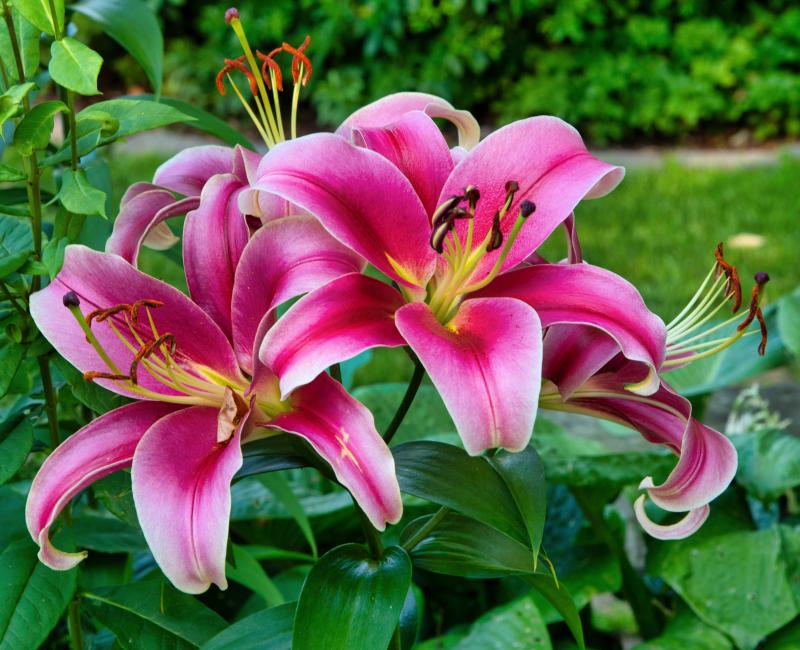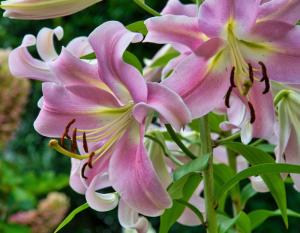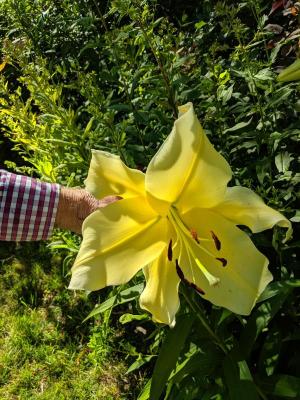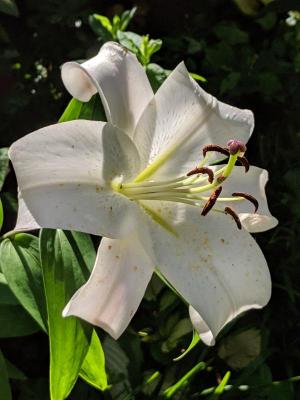Mill Pond Garden will hold an open garden day for the peak of its famous tree lilies from 10 a.m. to 1 p.m., Sunday, July 5. To subscribe to receive an invitation and a ticket, go to www.millpondgarden.com. Mill Pond Garden is a holistic community botanical garden at 31401 Melloy Court, Lewes.
Lilies bring astonishing flower size, beauty, height, fragrance, color and pollinators to gardens from mid-June to mid-August. Lilies offer different flowering periods and size of plants among their nine types and many hybrids. There are four lilies native to North America only one of which, the tiger lily, is easy to grow. However, it is not recommended since it hosts a disease that damages all other ornamental lily varieties. Mill Pond Garden recommends only the proven best types and cultivars, easy to grow in the Cape Region.
The best choices for local gardens are the tree lilies, also known as Orienpet, hybrid crosses between oriental lilies and trumpet lilies, and a few other hybrid lilies.
With huge flower heads and many of them on large panicles, skinny stems on many lily types can be an issue, causing them to flop. They need to be staked and tied for support. A bunch of stakes in a flower bed of lilies is an unhappy sight and extra maintenance work for the gardener, so Mill Pond Garden does not recommend skinny-stem lilies; it only recommends those that can stand up on their own and do well in all ways.
Lilies do not require a lot of moisture to thrive. To prevent lily plant problems, avoid overwatering during hot months. Make sure the planting soil is well-drained and light in texture, reducing the moisture that promotes fungal disease. A lily bulb produces about eight to 12 flowers per stem and they are in bloom for 10 to 20 days. Not all lilies are fragrant, but some are powerfully fragrant.
When planting lilies, Mill Pond recommends growing them in groups of three to five bulbs spaced about 18 inches apart. If too many are planted in a clump, it creates visual confusion. Plant lilies in fall or early spring about four to eight inches deep in well-drained soil, in a spot with morning sun and some afternoon shade. The best soil would be sandy with lots of fine pine bark mulch mixed in and some well-aged compost, or bagged cow manure, aged horse manure or leaf mold. The antifungal properties of well-aged horse manure are proven. Lilies need good air circulation and cool, dry conditions to avoid disease. Lilies are healthiest if on the dry side. The bulbs can be dug up and gently divided every three or four years.
The lilies recommended by Mill Pond Garden are sturdy, perform well, are wonderfully fragrant and include these specific cultivars, all reaching from four to seven feet tall: Conca d’Or (pale yellow), Anastasia (pink and white), Pretty Woman (huge white), Scheherazade (red and cream), LeVern Friemann (deep red), Lavon (yellow and red), Saronno (pure white, better than famed Casa Blanca), Terrasol (apricot), and Robina (raspberry). One famous and reliable oriental hybrid lily is Stargazer, about three feet tall and abundant. All these lilies are award winning in many forums, the best of the best, and proven garden-worthy locally at Mill Pond Garden.
Lilies do not bloom more than once per season, but gardeners can remove the faded flowers’ seed pods so the plants don't waste energy making seeds, but put that energy into making a bigger bulb for next year’s bloom. Lilies are perennial.
Locally, the main source for lilies is the bagged selections at garden centers and big-box stores. For the choices recommended above, gardeners should check online and check more than one source for largest bulbs. For best quality and bulb size, Mill Pond Garden has found satisfaction from an American company, B&D Lilies in Washington state, and smaller but quality bulbs from Van Engelen, a Dutch company with distribution from Connecticut. Source matters, since bulbs from some sources, usually cheaper, may arrive with disease, or too old and dried out. If a bulb arrives that does not look good, throw it away. A lily bulb should be white inside a papery onion-type skin.
Lilies have been central to art, culture, religion and gardens since ancient times. They may have been the first flowers cultivated by humans. Cultivating these beauties, gardeners will find something to celebrate.

























































